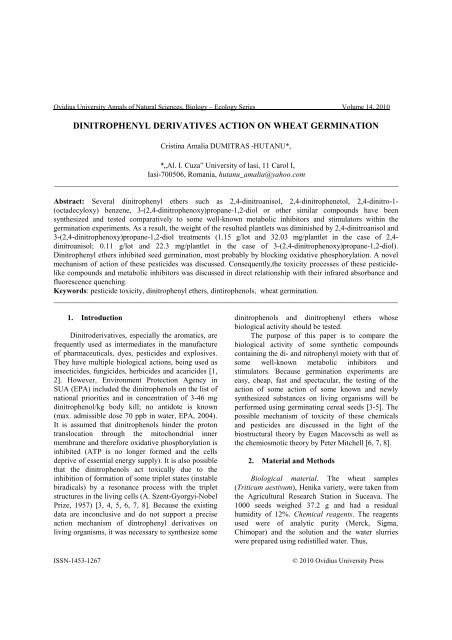VOLUM OMAGIAL - Facultatea de Ştiinţe ale Naturii şi Ştiinţe Agricole
VOLUM OMAGIAL - Facultatea de Ştiinţe ale Naturii şi Ştiinţe Agricole
VOLUM OMAGIAL - Facultatea de Ştiinţe ale Naturii şi Ştiinţe Agricole
You also want an ePaper? Increase the reach of your titles
YUMPU automatically turns print PDFs into web optimized ePapers that Google loves.
Ovidius University Annals of Natural Sciences, Biology – Ecology Series Volume 14, 2010<br />
DINITROPHENYL DERIVATIVES ACTION ON WHEAT GERMINATION<br />
Cristina Amalia DUMITRAS -HUTANU*,<br />
*„Al. I. Cuza” University of Iasi, 11 Carol I,<br />
Iasi-700506, Romania, hutanu_amalia@yahoo.com<br />
__________________________________________________________________________________________<br />
Abstract: Several dinitrophenyl ethers such as 2,4-dinitroanisol, 2,4-dinitrophenetol, 2,4-dinitro-1-<br />
(octa<strong>de</strong>cyloxy) benzene, 3-(2,4-dinitrophenoxy)propane-1,2-diol or other similar compounds have been<br />
synthesized and tested comparatively to some well-known metabolic inhibitors and stimulators within the<br />
germination experiments. As a result, the weight of the resulted plantlets was diminished by 2,4-dinitroanisol and<br />
3-(2,4-dinitrophenoxy)propane-1,2-diol treatments (1.15 g/lot and 32.03 mg/plantlet in the case of 2,4dinitroanisol;<br />
0.11 g/lot and 22.3 mg/plantlet in the case of 3-(2,4-dinitrophenoxy)propane-1,2-diol).<br />
Dinitrophenyl ethers inhibited seed germination, most probably by blocking oxidative phosphorylation. A novel<br />
mechanism of action of these pestici<strong>de</strong>s was discussed. Consequently,the toxicity processes of these pestici<strong>de</strong>like<br />
compounds and metabolic inhibitors was discussed in direct relationship with their infrared absorbance and<br />
fluorescence quenching.<br />
Keywords: pestici<strong>de</strong> toxicity, dinitrophenyl ethers, dintirophenols, wheat germination.<br />
__________________________________________________________________________________________<br />
1. Introduction<br />
Dinitro<strong>de</strong>rivatives, especially the aromatics, are<br />
frequently used as intermediates in the manufacture<br />
of pharmaceuticals, dyes, pestici<strong>de</strong>s and explosives.<br />
They have multiple biological actions, being used as<br />
insectici<strong>de</strong>s, fungici<strong>de</strong>s, herbici<strong>de</strong>s and acarici<strong>de</strong>s [1,<br />
2]. However, Environment Protection Agency in<br />
SUA (EPA) inclu<strong>de</strong>d the dinitrophenols on the list of<br />
national priorities and in concentration of 3-46 mg<br />
dinitrophenol/kg body kill; no antidote is known<br />
(max. admissible dose 70 ppb in water, EPA, 2004).<br />
It is assumed that dinitrophenols hin<strong>de</strong>r the proton<br />
translocation through the mitochondrial inner<br />
membrane and therefore oxidative phosphorylation is<br />
inhibited (ATP is no longer formed and the cells<br />
<strong>de</strong>prive of essential energy supply). It is also possible<br />
that the dinitrophenols act toxically due to the<br />
inhibition of formation of some triplet states (instable<br />
biradicals) by a resonance process with the triplet<br />
structures in the living cells (A. Szent-Gyorgyi-Nobel<br />
Prize, 1957) [3, 4, 5, 6, 7, 8]. Because the existing<br />
data are inconclusive and do not support a precise<br />
action mechanism of dintrophenyl <strong>de</strong>rivatives on<br />
living organisms, it was necessary to synthesize some<br />
dinitrophenols and dinitrophenyl ethers whose<br />
biological activity should be tested.<br />
The purpose of this paper is to compare the<br />
biological activity of some synthetic compounds<br />
containing the di- and nitrophenyl moiety with that of<br />
some well-known metabolic inhibitors and<br />
stimulators. Because germination experiments are<br />
easy, cheap, fast and spectacular, the testing of the<br />
action of some action of some known and newly<br />
synthesized substances on living organisms will be<br />
performed using germinating cereal seeds [3-5]. The<br />
possible mechanism of toxicity of these chemicals<br />
and pestici<strong>de</strong>s are discussed in the light of the<br />
biostructural theory by Eugen Macovschi as well as<br />
the chemiosmotic theory by Peter Mitchell [6, 7, 8].<br />
2. Material and Methods<br />
Biological material. The wheat samples<br />
(Triticum aestivum), Henika variety, were taken from<br />
the Agricultural Research Station in Suceava. The<br />
1000 seeds weighed 37.2 g and had a residual<br />
humidity of 12%. Chemical reagents. The reagents<br />
used were of analytic purity (Merck, Sigma,<br />
Chimopar) and the solution and the water slurries<br />
were prepared using redistilled water. Thus,<br />
ISSN-1453-1267 © 2010 Ovidius University Press





